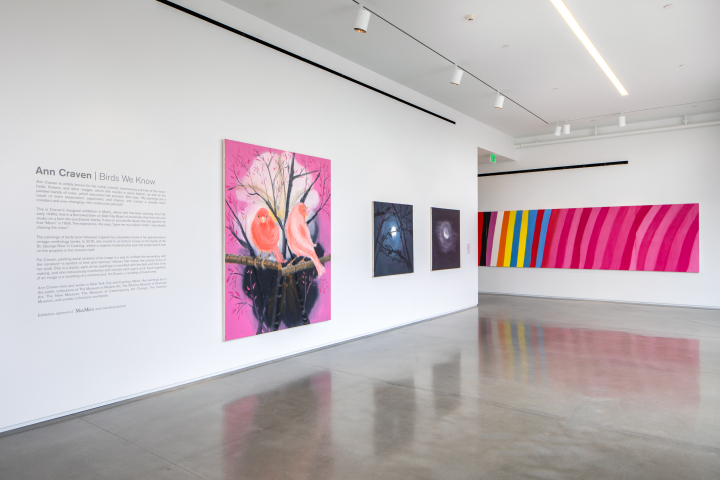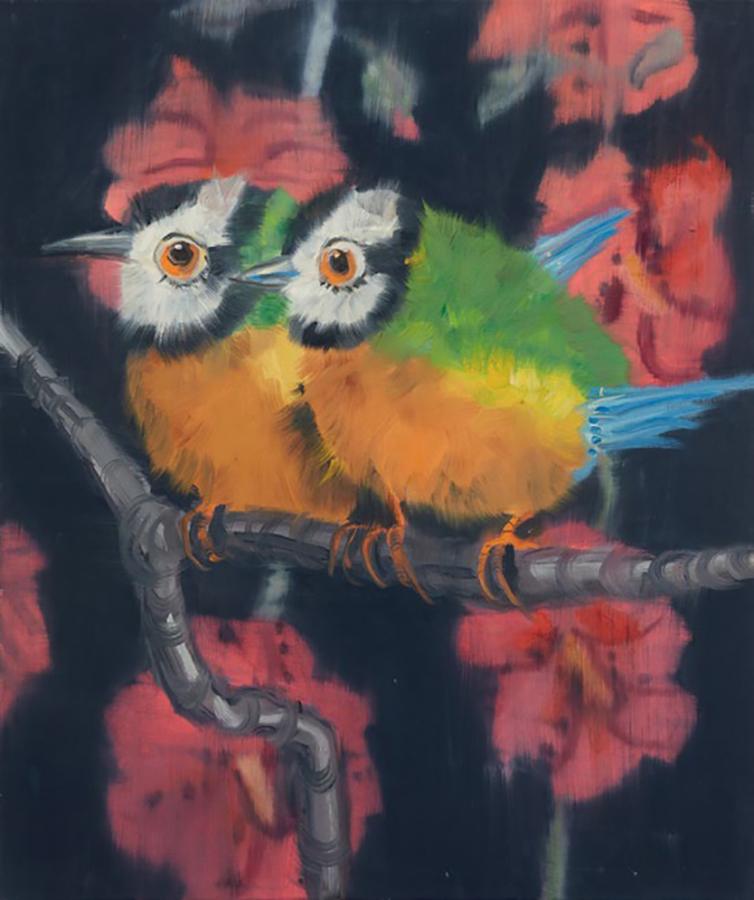September 7, 2019
Download as PDF
View on Hyperallergic
Ann Craven’s painted birds, set against a soft-focus background, have a kitsch quality, but with a provocative edge.

ROCKLAND, Maine — Birds have a long and varied history in art, ranging from works such as Giotto’s “St. Francis Preaching to the Birds” to van Gogh’s crows over a wheat field, and from natural history to fanciful, symbolic, and abstract renderings — for instance, Louise Nevelson’s “bird forms” or Brancusi’s aerodynamic “Bird in Space.” Birds are artists’ winged muses. Boston-born painter Ann Craven, who maintains studios in New York City and Cushing, Maine, has focused on birds for more than 20 years. Her current show, Birds We Know, at the Center for Maine Contemporary Art presents a plentiful selection from her career, nearly 40 oils on canvas ranging in size from 10 by 14 to 90 by 72 inches.
Craven’s creatures are common birds — nothing too exotic. Bluebirds, cardinals, canaries, crows, finches, woodpecker, and owls are among them. While identifiable, her depictions are neither naturalistic nor loose. They sometimes evoke the work of Alex Katz, and that’s no coincidence: Craven was his studio assistant early in her career.
The two light pink birds in “Big Pink I’m Sorry, 2008-2011” (the titles all include the date) perch on matching limbs, their cuteness partly offset by amorphous white and black clouds blooming in the background. Delicate tree branches bisect the space horizontally and vertically, dividing it into four quadrants. The paired birds’ positions — one of them facing us, the other turned away — creates a sense of communication, like a couple having a heart-to-heart. The sentiment and composition repeat in “I’m Sorry (on Black with Cherries), 2019,” this time with cherries dangling in the background.
Many of Craven’s portraits depict songbirds, reflected in titles like “Hit Song with Clouds, 2001,” which features a small orange-breasted bluebird, presumably singing a top ten tune. A similarly marked bird in “Bold as Love #1, 2007,” and “Bold as Love #2, 2007,” may be channeling Jimi Hendrix (the title references his famous album). These birds in full-throated song recall the varied thrush in the opening credits of Twin Peaks — a posed, even stiff, feathered friend.

Other images are downright charming: “Puff Puff, 2004,” features a winsome pair of wide-eyed, fluffed-up birds. By contrast, “Blue Song, 2003,” presents a blackbird, its silhouette charcoal black, in front of floating flowers on a light blue ground, while “Silhouette Birds (after Courbet), 2006,” presents two blackbirds in the show’s only winter scene. Setting the birds in many of the paintings against a soft-focus background lends them a kitsch quality, but with a provocative edge. The claws, when visible, are sometimes unsightly things—a contrast with the mostly beaming birds to which they’re attached.
The exhibition also includes two paintings from Craven’s ongoing moon series — like the birds started many years ago. In “Moon (Full Lovers Moon Again), 2007,” a hazy white orb radiates light from beyond the brush of tree branches. The image is romantic, a nocturne, but not exactly the transfigured night of the Romantic painters.
On the wall that leads from the CMCA’s lobby to the main gallery is a very large horizontal painting (60 by 384 inches), “Octaptych (Stripe, Birds We Know), 2019.”The eight connected panels are covered with irregular diagonal stripes in different hues. These are not the precision painted strips of a Bridget Riley canvas or one of Gene Davis’s formalist stripe designs. Rather, the piece seems to serve as a kind of overture to the bird pictures, providing the full spectrum of color that lies around the corner — an unusual, and nifty, transition piece.

Much of the press around the show has focused on the fact that Birds We Know is Craven’s first exhibition in Maine, where she has been painting since the early 1990s. In an interview with Portland Press Herald art reporter Bob Keyes, she referenced some of the angst she feels living in Cushing. The town’s artistic legacy, she says, is “just killing” her. Here, where Andrew Wyeth painted Christina Olson, where Bernard Langlais created his large-scale sculptures, where Lois Dodd and Alan Magee practice their formidable realism, she treads carefully. “The Maine landscape is a culprit, in a way, of this history,” she notes, “but at the same time it’s just an inspiring place to be.”
That Craven has managed to carve out her own place in this hot spot of creativity speaks to her ability to maintain focus and cultivate some engaging obsessions, including a flock of birds at once ordinary and out of the ordinary.



